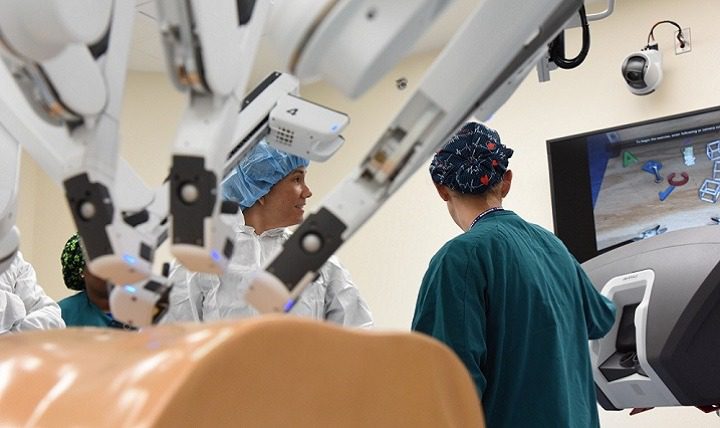Ask the Expert: Kornelis Poelstra, MD, PhD
The Spine Institute on the Emerald Coast
In your opinion, what are the top three innovations that you are excited about within the spinal health industry?
I have the exciting opportunity to witness innovation be born into the field of spinal health; to be able to leverage these advancements and contribute my own research on behalf of my patients is a true honor. The following is an introduction to three cutting-edge advancements in spinal medicine that I’d like to share with you:
Robotics
Having been one of the early adopters of robotic-assisted surgeries, it has been interesting to watch the progression of these technologies, along with my own confidence in them! While I felt the introduction of robotics in spine surgeries was inevitable, I was initially quite skeptical.
From improved screw placement accuracy, fewer complications, and less need for revisions, to decreased catastrophic malplacements due to perfectly executed planned trajectories, the benefits of robotics are numerous. Planning not just the individual screw trajectories, for example, but an entire construct including the skin incisions is hugely beneficial. I am no longer looking at one individual pedicle at a time as is done with navigation systems; with the robot I plan the entire line, thus greatly reducing operative times and improving overall accuracy.
The key for people to understand is that there is only a certain amount of stress one can handle per case; when using robotics for screw placement, you have no stress from creating an entire construct, so you can reserve that stress for more complicated tasks such as osteotomies and your decompressions. I foresee significant growth in years to come, perhaps even making robotic-assisted surgeries so automated that robotics will be primarily used in the majority of simple surgeries. In saying that, I do not believe the human factor will ever become obsolete; robotics will be used to enhance what surgical experts are trained to do. Not only have the current robots enhanced the patient’s surgical experience by reducing operative, hospitalization, and recovery times as well as radiation exposure, they have prepared us for the future.
By embracing robots now, while simple and easy to understand, we are better equipped to understand their capabilities, applicability, and limitations for the future. When more advanced robots are introduced, I’ll be ready! The better prepared I am, the better I can serve my patients. The question is not if robotics will continue to advance but how; perhaps real-time augmented reality headsets for surgeons will become the new norm, projecting the patient’s CT scans as a 3D model, allowing a surgeon to locate their tools in real time even if it’s below the skin. Whatever the possibilities, I am excited to see what the future holds for robotics in enhancing the patient and physician experience!
New Metals
I believe that new materials will bring the next wave of innovation in spine and I have been involved in introducing Molybdenum-Rhenium (MoRe) to orthopaedics. The benefit of this new material is that, compared to standard materials used in spine (cobalt-chrome, titanium, and stainless steel), it is stronger and more resistant to corrosion. Originally used to make stents in cardiology, MoRe’s strength, durability, and flexibility are important characteristics when it comes to inserting hardware that need to maintain a certain amount of load.
Another benefit is that the MoRe alloy contains no trace elements as compared to the nickel found in cobalt-chromium, for example. The hope for the future is that engineers can design far smaller implants with less metal while maintaining their integrity. Industry is also hopeful that the FDA will clear these advanced materials within the next few years for other uses such as joint replacements, fracture fixation, or other uses where improved osteointegration (connection between living bone and the surface of a load-carrying implant) is key to a successful outcome. This will present opportunity for enhanced implants with superior biomechanical properties, a smaller footprint, and more favorable surface characteristics.
The more favorable the implant surface is, the more likely bone-forming cells will thrive. However, not all implants are created equal! Implants made with hydrophilic materials attract water, whereas ones made from hydrophobic materials expel water. The plastics that are used in spine are often hydrophobic; bone has a hard time attaching to them. MoRe is even more hydrophilic, or “wettable” than classic titanium, making it more favorable for bone growth. In our studies, bone formation looked better on MoRe than on titanium.
3D Printing Technologies
3D printing technologies offer a tremendous asset to orthopedic and spinal surgery. The acceptance of 3D printing technologies allows us to create tailored implants for patients as well as the possibility for the creation of improved surface characteristics at the bone-implant interface. Let’s look at the ability to print implants with different levels of elasticity. Our bones constantly sustain a pressurized load and must have a level of stiffness to be able to resist too much bend; they also must be flexible enough to absorb energy, compress when needed, and lengthen without cracking. The ability to 3D print implants with differing levels of elasticity (stiff yet flexible) allows physicians to meet the needs of a specific patient.
A younger and healthier patient may need a stiffer implant, whereas a relatively more “flexible” implant may be more suited for an older patient with osteopenia or osteoporosis. No matter how stiff or flexible, the key is to accommodate the patient’s needs and create an environment for the implant to fit better onto and into the bone, making reconstruction surgeries easier and more effective. In addition to 3D printing technologies, there are new insights into the potential of bioprinting – combining cells, growth factors, and biomaterials to produce biomedical materials that imitate natural tissues. The future of combining 3D-printed technologies with bioprinted materials will be the ability to expand an implant as needed, to change angulations of the end plates where needed, and to eventually reduce the need of ‘traditional’ bone grafting in these 3D-printed structures!
While original PEEK implants had the advantage of being transparent on radiographs, they had a hydrophobic surface. New hydrophilic materials
can be combined with biomaterials to create a seamless “velcro” attachment against the bone, creating an immediately stable environment. I foresee that hardware removals will become less necessary with the acceptance of these bioactive surfaces, as we will eventually be able to 3D print ‘active’ implants for specific age and bone density needs. I also see the potential use of (tiny) incorporated Wifi-powered microchips providing us information on our own cellphone about the status of bone incorporation and fusion between the bones and our ‘smart’ implant. Exciting things are here to come!!

by Kornelis Poelstra, MD, PhD, The Spine Institute on the Emerald Coast



